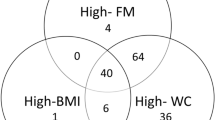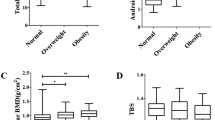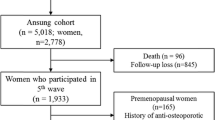Abstract
Summary
Associations of adiposity indices with bone mineral density (BMD) and bone turnover markers were evaluated in Chinese participants. Body mass index, fat mass, and lean mass are positively related to BMD in both genders. Subcutaneous fat area was proved to be negatively associated with BMD and positively correlated with osteocalcin in postmenopausal females.
Introduction
Obesity is highly associated with osteoporosis, but the effect of adipose tissue on bone is contradictory. Our study aimed to assess the associations of adiposity indices with bone mineral density (BMD) and bone turnover markers (BTMs) in the Chinese population.
Methods
Our study recruited 5215 participants from the Shanghai area, evaluated related anthropometric and biochemical traits in all participants, tested serum BTMs, calculated fat distribution using magnetic resonance imaging (MRI) images and image analysis software, and tested BMD with dual-energy X-ray absorptiometry.
Results
When controlled for age, all adiposity indices were positively correlated with BMD of all sites for both genders. As for the stepwise regression analysis, body mass index (BMI), fat mass, and lean mass were protective for BMD in both genders. However, subcutaneous fat area (SFA) was detrimental for BMD of the L1–4 and femoral neck (β ± SE −0.0742 ± 0.0174; p = 2.11E−05; β ± SE −0.0612 ± 0.0147; p = 3.07E−05). Adiposity indices showed a negative correlation with BTMs adjusting for age, especially with osteocalcin. In the stepwise regression analysis, fat mass was negatively correlated with osteocalcin (β ± SE −8.8712 ± 1.4902; p = 4.17E−09) and lean mass showed a negative correlation with N-terminal procollagen of type I collagen (PINP) for males (β ± SE −0.3169 ± 0.0917; p = 0.0006). In females, BMI and visceral fat area (VFA) were all negatively associated with osteocalcin (β ± SE −0.4423 ± 0.0663; p = 2.85E−11; β ± SE −7.1982 ± 1.1094; p = 9.95E−11), while SFA showed a positive correlation with osteocalcin (β ± SE: 5.5993 ± 1.1753; p = 1.98E−06).
Conclusion
BMI, fat mass, and lean mass are proved to be beneficial for BMD in both males and postmenopausal females. SFA is negatively associated with BMD and positively correlated with osteocalcin in postmenopausal females.
Similar content being viewed by others
References
Svedbom A, Hernlund E, Ivergard M, Compston J, Cooper C, Stenmark J, McCloskey EV, Jonsson B, Kanis JA (2013) Osteoporosis in the European Union: a compendium of country-specific reports. Arch Osteoporos 8:137. doi:10.1007/s11657-013-0137-0
Qu B, Ma Y, Yan M, Wu HH, Fan L, Liao DF, Pan XM, Hong Z (2014) The economic burden of fracture patients with osteoporosis in western China. Osteoporos Int 25(7):1853–1860. doi:10.1007/s00198-014-2699-0
Hernandez-Rauda R, Martinez-Garcia S (2004) Osteoporosis-related life habits and knowledge about osteoporosis among women in El Salvador: a cross-sectional study. BMC Musculoskelet Disord 5:29. doi:10.1186/1471-2474-5-29
Reid IR (2008) Relationships between fat and bone. Osteoporos Int 19(5):595–606. doi:10.1007/s00198-007-0492-z
Lloyd JT, Alley DE, Hochberg MC, Waldstein SR, Harris TB, Kritchevsky SB, Schwartz AV, Strotmeyer ES, Womack C, Orwig DL (2016) Changes in bone mineral density over time by body mass index in the health ABC study. Osteoporos Int 27(6):2109–2116. doi:10.1007/s00198-016-3506-x
Reid IR (2010) Fat and bone. Arch Biochem Biophys 503(1):20–27. doi:10.1016/j.abb.2010.06.027
Douchi T, Oki T, Nakamura S, Ijuin H, Yamamoto S, Nagata Y (1997) The effect of body composition on bone density in pre- and postmenopausal women. Maturitas 27(1):55–60
Zhao LJ, Liu YJ, Liu PY, Hamilton J, Recker RR, Deng HW (2007) Relationship of obesity with osteoporosis. J Clin Endocrinol Metab 92(5):1640–1646. doi:10.1210/jc.2006-0572
Jankowska EA, Rogucka E, Medras M (2001) Are general obesity and visceral adiposity in men linked to reduced bone mineral content resulting from normal ageing? A population-based study. Andrologia 33(6):384–389
Reid IR (2002) Relationships among body mass, its components, and bone. Bone 31(5):547–555
Pou KM, Massaro JM, Hoffmann U, Vasan RS, Maurovich-Horvat P, Larson MG, Keaney JF Jr, Meigs JB, Lipinska I, Kathiresan S, Murabito JM, O’Donnell CJ, Benjamin EJ, Fox CS (2007) Visceral and subcutaneous adipose tissue volumes are cross-sectionally related to markers of inflammation and oxidative stress: the Framingham Heart Study. Circulation 116(11):1234–1241
Gilsanz V, Chalfant J, Mo AO, Lee DC, Dorey FJ, Mittelman SD (2009) Reciprocal relations of subcutaneous and visceral fat to bone structure and strength. J Clin Endocrinol Metab 94(9):3387–3393. doi:10.1210/jc.2008-2422
Cui LH, Shin MH, Kweon SS, Park KS, Lee YH, Chung EK, Nam HS, Choi JS (2007) Relative contribution of body composition to bone mineral density at different sites in men and women of South Korea. J Bone Miner Metab 25(3):165–171. doi:10.1007/s00774-006-0747-3
Lekamwasam S, Weerarathna T, Rodrigo M, Arachchi WK, Munidasa D (2009) Association between bone mineral density, lean mass, and fat mass among healthy middle-aged premenopausal women: a cross-sectional study in southern Sri Lanka. J Bone Miner Metab 27(1):83–88. doi:10.1007/s00774-008-0006-x
Rachner TD, Khosla S, Hofbauer LC (2011) Osteoporosis: now and the future. Lancet 377(9773):1276–1287. doi:10.1016/S0140-6736(10)62349-5
Garnero P (2008) Biomarkers for osteoporosis management: utility in diagnosis, fracture risk prediction and therapy monitoring. Mol Diagn Ther 12(3):157–170
Blake GM, Fogelman I (2007) The role of DXA bone density scans in the diagnosis and treatment of osteoporosis. Postgrad Med J 83(982):509–517. doi:10.1136/pgmj.2007.057505
Lloyd JT, Alley DE, Hawkes WG, Hochberg MC, Waldstein SR, Orwig DL (2014) Body mass index is positively associated with bone mineral density in US older adults. Arch Osteoporos 9:175. doi:10.1007/s11657-014-0175-2
Porter SA, Massaro JM, Hoffmann U, Vasan RS, O’Donnel CJ, Fox CS (2009) Abdominal subcutaneous adipose tissue: a protective fat depot? Diabetes Care 32(6):1068–1075. doi:10.2337/dc08-2280
Palmer BF, Clegg DJ (2015) The sexual dimorphism of obesity. Mol Cell Endocrinol 402:113–119. doi:10.1016/j.mce.2014.11.029
Finkelstein JS, Brockwell SE, Mehta V, Greendale GA, Sowers MR, Ettinger B, Lo JC, Johnston JM, Cauley JA, Danielson ME, Neer RM (2008) Bone mineral density changes during the menopause transition in a multiethnic cohort of women. J Clin Endocrinol Metab 93(3):861–868. doi:10.1210/jc.2007-1876
Khosla S, Oursler MJ, Monroe DG (2012) Estrogen and the skeleton. Trends in endocrinology and metabolism: TEM 23(11):576–581. doi:10.1016/j.tem.2012.03.008
Manolagas SC (2000) Birth and death of bone cells: basic regulatory mechanisms and implications for the pathogenesis and treatment of osteoporosis. Endocr Rev 21(2):115–137. doi:10.1210/edrv.21.2.0395
Yoo HJ, Park MS, Yang SJ, Kim TN, Lim KI, Kang HJ, Song W, Baik SH, Choi DS, Choi KM (2012) The differential relationship between fat mass and bone mineral density by gender and menopausal status. J Bone Miner Metab 30(1):47–53. doi:10.1007/s00774-011-0283-7
Kang DH, Guo LF, Guo T, Wang Y, Liu T, Feng XY, Che XQ (2015) Association of body composition with bone mineral density in northern Chinese men by different criteria for obesity. J Endocrinol Investig 38(3):323–331. doi:10.1007/s40618-014-0167-5
Bredella MA, Lin E, Gerweck AV, Landa MG, Thomas BJ, Torriani M, Bouxsein ML, Miller KK (2012) Determinants of bone microarchitecture and mechanical properties in obese men. J Clin Endocrinol Metab 97(11):4115–4122. doi:10.1210/jc.2012-2246
Acknowledgments
This work was supported by grants from the National 863 Program (2015AA020110), National Key Research and Development Project (2016YFC1304902), Drug Innovation Program of the National Science and Technology Project (2011ZX09307-001-02), Shanghai Young Doctor Training and Funding Program, Shanghai Jiao Tong Medical/Engineering Foundation (YG2014MS18), Shanghai Municipal Education Commission–Gaofeng Clinical Medicine Grant Support (20152527), National Program for Support of Top-notch Young Professional, Shanghai Health and Family Planning Commission (2013ZYJB1001), Innovation Foundation of Translational Medicine of Shanghai Jiao Tong University School of Medicine (15ZH4006), Shanghai SJTUSM Biobank, and Shanghai Hospital Development Center (SHDC12013115). We acknowledge the assistance of the nursing and medical staff at the Shanghai Clinical Center for Diabetes. We gratefully appreciate all of the participants in this research.
Author information
Authors and Affiliations
Corresponding authors
Ethics declarations
Conflict of interest
None.
Electronic supplementary material
ESM 1
(DOC 85 kb)
Rights and permissions
About this article
Cite this article
Wang, J., Yan, D., Hou, X. et al. Association of adiposity indices with bone density and bone turnover in the Chinese population. Osteoporos Int 28, 2645–2652 (2017). https://doi.org/10.1007/s00198-017-4081-5
Received:
Accepted:
Published:
Issue Date:
DOI: https://doi.org/10.1007/s00198-017-4081-5




